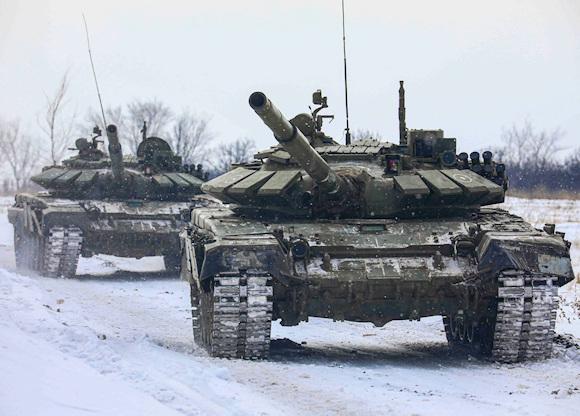The most recent Russian tactics studies have focused on operations in the Crimea, Eastern Ukraine and Syria. Russia has exploited the Ukrainian and Syrian conflicts to experiment with new materials and armaments and, nevertheless, to verify technical-tactical procedures which are important lessons learned.
In particular, Moscow has had the opportunity to test numerous air, naval and land weapons systems on the Syrian theater, verifying their strengths and vulnerabilities.
Specifically in the Ukrainian operational theater, Russia has had eight years to learn in detail the technical-tactical procedures of the Ukrainian regular forces, observing how much of the old Soviet military doctrine, intrinsic heritage of the military culture of Ukraine, is still consolidated and how much has changed since the collapse of the Soviet Union. By way of example, we recall how, starting from 2014, Ukraine has strengthened its arsenals with the acquisition of production armaments of the NATO area, such as anti-tank missile systems. Javelins and drones supplied by Turkey.
It should not be forgotten that when it was part of the USSR, Ukroboronprom (the Defense Industry of Ukraine) produced a third of Soviet armament. It is a fact that, in the event of an armed conflict, the two contenders would find themselves fighting mainly with the same weapons, well known to both, but not only: the same tactics and even the same language! However, in the latter respect, the Ukrainians enjoy the small advantage of having their own language, not necessarily intelligible by the Russian military.

I defined this advantage as “small” because, let's not forget, the “asymmetrical” component made up of pro-Russian paramilitary formations capable of understanding both languages active in the Donbass for eight years, can significantly contribute to reducing this advantage.
The fact that the Russians apply certain tactics in one situation does not mean that they do the same in another. On this aspect, General Gerasimov - Chief of Staff of the Russian Armed Forces - paraphrasing the eminent Russian strategist General Alexander Svechin, expressed himself as follows: "Each war represents an isolated case, which requires an understanding of its particular logic, its unique character."1
This statement suggests that the Russians would not fight an equal opponent on the level of conventional warfare in the same way as in the recent conflicts that have seen them engaged against opponents of inferior size and capacity. While in the current Western military doctrines the focus to the asymmetric threat (criminal gangs, terrorists, insurgents, mercenaries, paramilitary groups, hacker etc.), the ways in which Russia would currently develop its operations in a context of symmetrical warfare, with the use of units at the level of pluriarm brigade and division, have been quite neglected.
Battalion-level units would appear to be the most suitable tool for projection of Russian forces into Eastern Ukraine, but the Russians find a combination of divisions and brigades essential for combat with technologically advanced tools against peer forces. To confirm this, theintelligence available indicates among the Russian units deployed along the Russian-Ukrainian border the 150th Motorized Infantry Division, units with strong historical roots that have their roots in the enterprises carried out during the "Great Patriotic War" (Russian denomination of World War II).
 It is therefore necessary to be able to prioritize threats in relation to these capabilities. Criminal gangs, terrorists, and insurgents may be able to prevent a commander from achieving their goals, but these entities generally cannot destroy units such as a regular brigade. The "asymmetric forces" mentioned are certainly not comparable to the heavy Russian conventional forces. Therefore, it is interesting to analyze how Russia has fought to date in the Donbass and Syria against opponents of lower level and capacity, but it is also appropriate to focus on the formations and capabilities that the Russians are developing and how these are being trained to fight opponents. of equal level.
It is therefore necessary to be able to prioritize threats in relation to these capabilities. Criminal gangs, terrorists, and insurgents may be able to prevent a commander from achieving their goals, but these entities generally cannot destroy units such as a regular brigade. The "asymmetric forces" mentioned are certainly not comparable to the heavy Russian conventional forces. Therefore, it is interesting to analyze how Russia has fought to date in the Donbass and Syria against opponents of lower level and capacity, but it is also appropriate to focus on the formations and capabilities that the Russians are developing and how these are being trained to fight opponents. of equal level.
La Doctrine Gerasimov it would then seem to have reached its most delicate and bloody phase, that which foresees i boots on the ground of regular troops as a decisive action before the resumption of diplomatic activities to be undertaken, if possible, by dictating the "rules of the winner". In the light of the now famous doctrine that takes its name from the Chief of Staff of the Russian Armed Forces, this phase of combat should be exhausted quickly. In 2008 in Georgia it went like this, but here we would not limit ourselves to the vibrant protests formulated in the aftermath of the brief conflict between Moscow and Tbilisi and history teaches us that even the Blitzkrieg German should have led to the dominion of the III Rich quickly, but so - after all, fortunately - it was not.
Over the past two years, the Russians have deployed a certain number of military units, some of which are of considerable size, along the entire border with Ukraine, for an estimated total of 120.000 men. In reality, it is not just about sent units and following the best practices for the so-called "exercises", but rather units that have integrated and reinforced the Russian device already present in the area. In all this, Putin was also able to benefit from the availability of his faithful Belarusian ally, willing to accept the presence of a substantial number of Russian units on his territory and, nevertheless, to offer any support with his own troops, if necessary. In other words, the consistency of the Russian deployment from Crimea (indeed occupied without firing a shot) on the border with Belarus has seen the number of operational units doubled throughout the sector.
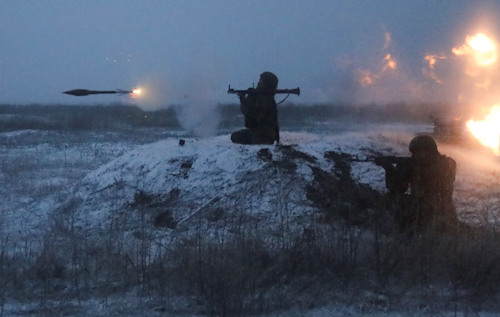 Given that the current balance of forces between the Russian and Ukrainian Armed Forces are four to one in favor of the Kremlin and, therefore, exceed those of three to one which are conventionally considered adequate for the party benefiting from this favorable proportion to lead an attack, it can reasonably be said that the current Russian deployment could foreshadow the imminence of an invasion of Ukrainian soil.
Given that the current balance of forces between the Russian and Ukrainian Armed Forces are four to one in favor of the Kremlin and, therefore, exceed those of three to one which are conventionally considered adequate for the party benefiting from this favorable proportion to lead an attack, it can reasonably be said that the current Russian deployment could foreshadow the imminence of an invasion of Ukrainian soil.
For several days, the images broadcast by the news show military vehicles constantly passing along the border between Russia and Ukraine, engaged in long "exercises" involving dozens of units of the most disparate specialties.
It is clear that here we are going far beyond the spirit of the so-called "grand maneuvers" periodically carried out by each nation.
It is necessary to pause for a moment and reflect to understand the meaning of this surreal atmosphere of "conventional Doctor Strangelove", which I define as such because, at least so far, the nuclear threat remains in the background, due to the newspapers still available in Moscow.
The images that are shown to us by the media to the majority of people may communicate nothing more than a feeling of bitterness and discomfort, humanly understandable and limited to some popular vulgate considerations. In reality, in the few seconds of the various frames that appear on the screen, a professional eye would instead grasp the significance of the deployment of the BMP-2 and BMP-3 alternating with the rapid movements of the T-72 and T-90 tanks, which they move along muddy roads or advance in "open" formation across vast rural areas.
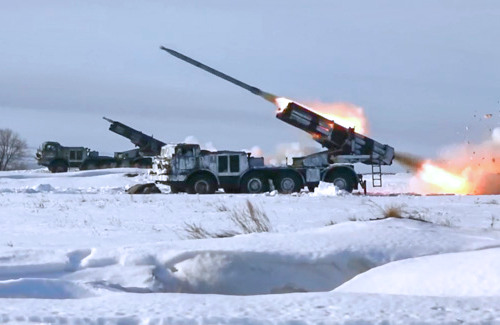 Other images captured by American satellites, taken by reporter near the territorial demarcation lines or, extremely significant fact, issued by the Russian press agencies, in the framework of the massive propaganda campaign in support of their "muscularity" and offensive capacity, they portray the troop transport vehicles of the BMP family, the tanks of the type mentioned, as well as systems for air defense Pantsir series, S-300 and S-400 anti-aircraft missile systems, BM-21 multiple rocket launchers City (Photo) - apparently obsolete artillery, actually still effective and deadly in its use as a "area saturation" weapon -, surface-to-surface missile systems 9K720 Iskander. Again, for the layman, these names and these acronyms may mean little or nothing, but for the experts they allow us to prefigure different hypotheses of conventional war development.
Other images captured by American satellites, taken by reporter near the territorial demarcation lines or, extremely significant fact, issued by the Russian press agencies, in the framework of the massive propaganda campaign in support of their "muscularity" and offensive capacity, they portray the troop transport vehicles of the BMP family, the tanks of the type mentioned, as well as systems for air defense Pantsir series, S-300 and S-400 anti-aircraft missile systems, BM-21 multiple rocket launchers City (Photo) - apparently obsolete artillery, actually still effective and deadly in its use as a "area saturation" weapon -, surface-to-surface missile systems 9K720 Iskander. Again, for the layman, these names and these acronyms may mean little or nothing, but for the experts they allow us to prefigure different hypotheses of conventional war development.
Meanwhile, it must be said that, in response to NATO's eastward expansion, perceived as a threat directly aimed at its prestige, its politics and, nevertheless, its territorial integrity, Moscow has now gone too far not to give rise to a “Loss of credibility” both towards the West and towards its historical allies scattered around the globe.
If you want to avoid the so-called escalation, it is necessary that the United States (in primis) and Europe to follow, offer Putin the opportunity not to "lose face". In concrete terms, despite the right of each state to choose the allies it prefers, this translates into not insisting on an attitude aimed at incorporating at all costs any country that manifests its willingness to join NATO or the European Union. It is one thing to enter into relationships with partnerships economic, another forging alliances of a military nature that can humiliate the Kremlin, already defeated by the confrontation of the Cold War. Having said that, we are faced, first of all, with the risk of searching for a potential casus belli by the Kremlin. There are well-known suspicions that behind the (successful) attacks in Moscow and that of Ryazan '(failed) in 2009, events that gave Putin the opportunity to organize the repression that resulted in the 2nd Chechen War, there was the longa manus of the FSB.
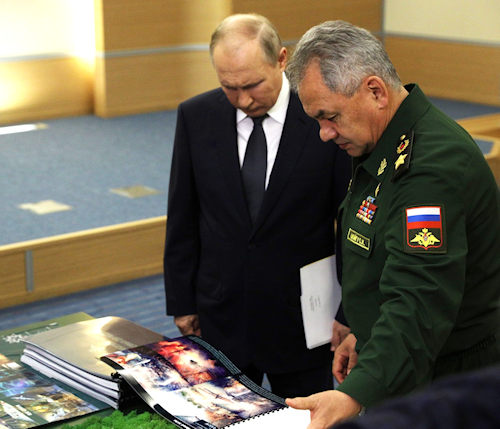 So what would be the main operational lines that can be identified among the different ones that the Kremlin could implement if it decided to implement the most extreme phase of the “Gerasimov Doctrine”, that is, armed confrontation?
So what would be the main operational lines that can be identified among the different ones that the Kremlin could implement if it decided to implement the most extreme phase of the “Gerasimov Doctrine”, that is, armed confrontation?
I will try, on the basis of my personal professional experience, to outline two of them: one more likely and one more dangerous.
The most likely hypothesis would see the implementation of a series of cyber attacks aimed at neutralizing the adversary command and control systems, as well as inhibiting the use of electrical networks and channels for public communication (Internet etc.). The action could continue with some strike conducted with aircraft and surface-to-surface missile systems, on the premise of the actual invasion with the land forces, so it is conceivable the development of the main effort along the east-west lines that from the Rostov oblast (permanent location of the aforementioned 150 ^ division) allege to the Donbass. In this case, theend-state for Moscow it could be the occupation of the Donbass for the annexation to its own territory and the recognition of this region and the previous conquest (Crimea) by the international community as de facto belonging to the Russian territory.
Il casus belli it could be offered by the fact that, to date, Russia has issued over 700.000 passports to as many Russian-speaking Ukrainian citizens and residents of the disputed region. They, seen as Russian citizens in all respects, would be seen as a population oppressed and subject to the rules of Kiev and, therefore, deserving of the intervention by the "Great Mother Russia".
The second hypothesis, the more dangerous one, always sees an attack from the east to first occupy the Donbass and then extend the maneuver to take control of the whole Ukrainian territory east of the Dnieper River, the industrial area of the country. If successful, Russian troops could cross the Dnieper River and continue fairly swiftly westward, through relatively rural territories, similar to those on which they have conducted recent "drills". Let's keep in mind, for example, the presence of missiles Iskander on the operational scenario which, with a range of 400 km are suitable for hitting targets in depth, well beyond the distance between the Russian border and the western edge of the region.
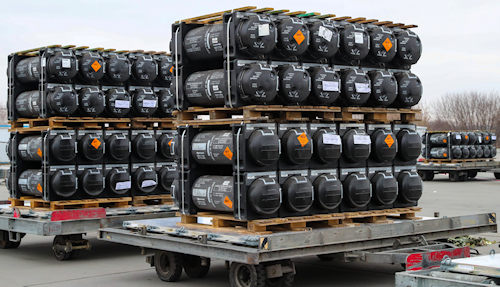
The main effort could be developed in the direction of Kiev for the conquest of the Ukrainian capital. A likely and significant secondary effort would be conducted along the Black Sea to seize Odessa and its port facilities, k-terrain for large-scale employment. Conquering Odessa would disrupt Ukraine's access to the sea and international markets and increase Russia's influence on Black Sea trade.end-state it could coincide with the taking of Kiev and the request to NATO not to continue further in the enlargement of the Alliance.
Whatever the hypothesis, Russia will likely have to act soon or avoid undertaking any maneuvers to the West until the summer months. In March the infamous rasputitsa, the melting of snow and ice, in the area of operations, transforms the earth into mud and swamp and the muddy ground certainly would not facilitate the progression of armored vehicles, as well as create "bottlenecks" that would make the vehicles easy targets for missiles anti-tank (photo).
Whatever the reasons for either side, whoever triggers a conflict as an occupation force is in principle wrong. One wonders if Putin doesn't want to be remembered as a sort of XNUMXst century Hitler. Among other things, the choice to fight a conventional war would have a high cost in human lives on both fronts and, recalling the words of a famous song by Sting, it is to be hoped that "... Russians love their children too".
A bad choice on Putin's part could turn out to be a boomerang even at the level of internal consensus, despite the sense of homeland that belongs to the sentiments of a large part of the Russian people.
1 V. Gerasimov, Ценность Науки в Предвидении (The value of science in prediction), Corriere Militare-Industriale, edited by the Russian Academy of Military Sciences, 23/02/2013.
Photo: MoD Russian Federation / MoD Ukraine / Kremlin

